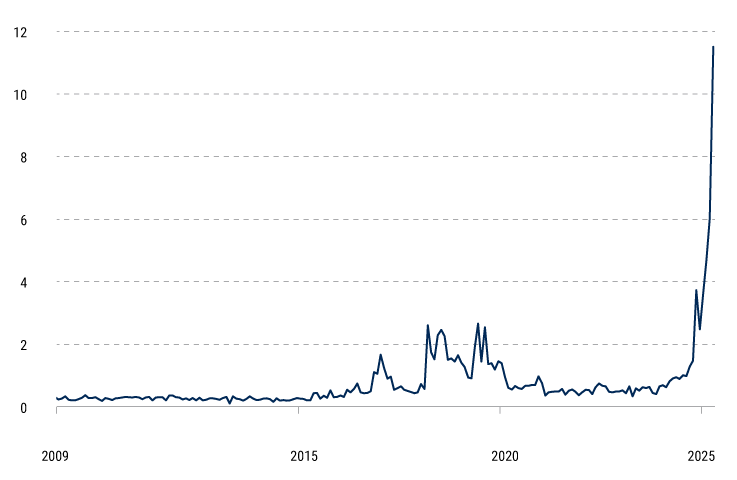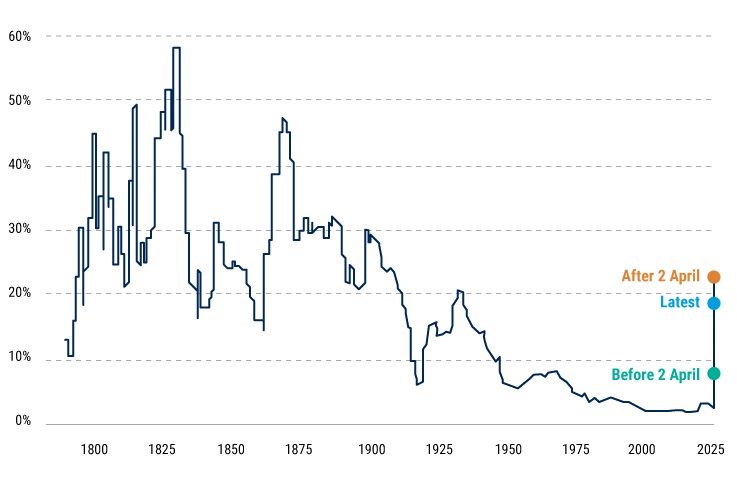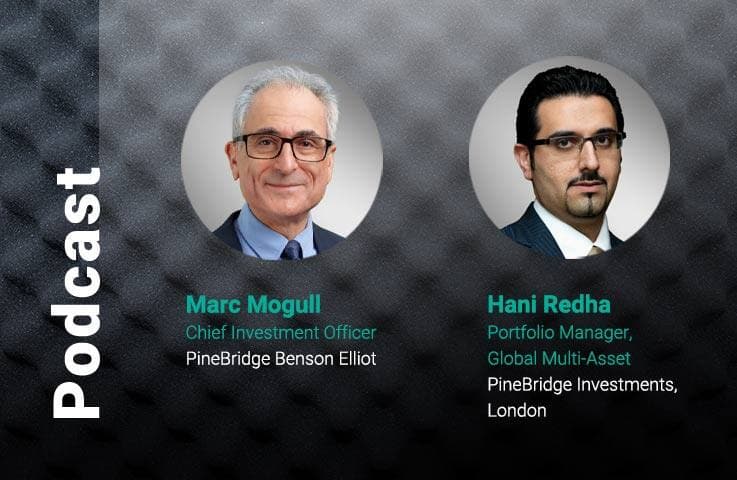Investing Amid Peak Uncertainty: A Cross-Asset-Class View

Steven Oh, CFA
Global Head of Credit and Fixed Income, Co-Head of Leveraged Finance

Jeremy H. Burton, CFA
Portfolio Manager, US High Yield and Leveraged Loans

Ash Shetty, CFA
Portfolio Manager and Risk Strategist, Developed Markets Fixed Income

Anders Faergemann
Head of Global Sovereigns & Economics

Michael J. Kelly, CFA
Global Head of Multi-Asset

Hani Redha, CAIA
Portfolio Manager, Head of Strategy and Research for Global Multi-Asset

Rob Hinchliffe, CFA
Portfolio Manager, Head of Global Sector Cluster Research

Kenneth Ruskin, CFA
Director of Research and Head of Sustainable Investing – Global Equities

Christopher Pettine, CFA
Healthcare Analyst - Global Equities
Trump’s tariffs have created a shock of historic magnitude – US tariffs now average a trade-weighted 18%, reviving stagflation fears.
The global monetary policy response is muted but shifting – Fed and ECB guidance is leaning dovish as risks mount.
US assets are losing shine – a weakening dollar and fading US exceptionalism favor broader global diversification.
Opportunities are emerging amid the dislocation – select European and emerging market credit and mispriced industrials offer long-term potential.
Balanced positioning should be the rule, while using periods of volatility opportunistically to add selective risk exposure – in leveraged finance, investment grade credit, and equities.

Markets have entered a new era of turbulence. President Trump’s sweeping tariff announcements on 2 April shocked global investors, unleashing volatility across asset classes and raising fundamental questions about US stability. As investors digest the reality of a rapidly changing global trade order, they face a singular challenge: how to position in a world where assumptions are breaking down faster than policies can catch up.
We believe the times call for thoughtful active management that takes a measured longer-term view while also remaining attuned to opportunities that arise from heightened volatility. Here we offer our latest views on the macroeconomic picture and how investors across asset classes can best position for the turbulence ahead.
Trade Uncertainty Has Reached Record Highs
Bloomberg Economics Global Trade Policy Uncertainty Index

Source: Bloomberg Economics as of April 2025.
Tariff turmoil and the macro picture
The new US tariffs are now at a trade-weighted average of roughly 18%, with a prohibitively high tariff on China creating a near embargo, significant rates on Canada and Mexico, and around a 10% average for the rest of the world. The tariffs are widely expected both to hurt growth and spur inflation, and while a soft landing for the economy remains our base case, we now see 40% chance for a mild recession. The policy response is also uncertain, and the stagflationary nature of the shock means that fiscal and monetary offsets may not arrive soon enough to sidestep a downturn.
Trump’s Proposed Tariffs Are the Highest in More Than a Century, Averaging 18%
Average trade-weighted tariff

Source: The Budget Lab at Yale as of 8 April 2025.
The Fed remains in “wait and see” mode despite overt pressure from Trump to cut rates. That said, we expect that entering 2026, the US economy will have slowed and price levels will most likely have adjusted after a one-off spike in inflation, enabling the Fed to be more dovish. Given these realities, we project that the Fed will cut its policy rates three times over the next 12 months to 3.75% and set our US 10-year rate forecast at 4.00%.
The outlook for the euro area is much clearer. Despite the lack of full clarity on tariffs, their impact implies weaker growth and disinflation, and our ECB policy rate forecast is 1.50%.
Turning to currencies, US exceptionalism is clearly fading for the short term, and risks are rising for investors either hedging the US dollar or rotating away from US assets. Moreover, weaker technicals and flows in the US dollar will not be offset by yield differentials. The euro benefits from Europe’s better policy mix, along with higher potential growth in Germany from 2026 onward. We’ve thus revised our euro/USD forecast to 1.1500 (from 1.0750) and have also revised our USD/JPY forecast to 140.00 (from 150.00), on a broadly weaker dollar.
Fixed income: diversify, diversify, diversify
The biggest surprise following recent tariff woes may be how calm the corporate credit markets have been relative to the rates or equity markets. Corporate credit is on a solid foundation heading into a potential slowdown or mild recession, but the overarching issue is arguably whether the US government’s actions could more permanently erode confidence in the US financial markets. The selling off of Treasury bonds may signal a lack of foreign buyer demand and is likely one of the reasons the dollar has weakened. If confidence and trust in the US are permanently damaged, this will have longer-term implications for demand and pricing of US assets and will weigh on future growth expectations from both a macro standpoint and for corporate earnings.
In an uncertain environment, the bottom line is that investors need to be more diversified across asset classes, industries, and global geographies. While some level of security selection risk is unavoidable, investors should try to avoid excess market risk in either direction.
We believe global diversification is especially critical. US credit, and its underlying fundamentals, have long been viewed as superior, but the differential is shrinking – and because of that, and given the current heightened uncertainty, we would not favor being overly weighted to the US.
We are now more constructive on the European outlook, given that the Trump administration is forcing Europe to rethink its fiscal expenditures on both military and infrastructure, especially in Germany. Europe may also benefit from a kind of forced collaboration on trade issues and spending after the bloc had started to fracture, leading to a more positive outcome down the road despite some short-term pain.
Parts of emerging markets are also on a solid footing, with the vast majority of EM corporates having fairly minimal exposure to trade to the US. Notably, the banking sector across emerging markets is generally well-positioned to withstand downside risks in the global economy, and while rate cuts have reduced profitability, these cuts factor into a stable economic outlook that supports loan quality and liquidity across the system.
We also believe recent volatility shows that Asian US dollar credit may be an interesting alternative to US and European fixed income, particularly in a drawdown environment.
Valuations look fair to us at both the security and market level, with neither screaming deals nor excessive tightness. Looking ahead, we think valuations are more likely to cheapen than tighten given the potential for more negative headlines.
Investment grade credit is relatively immune and could present buying opportunities
While we don’t believe investment grade (IG) credit is at significant risk from the tariff policies now unfolding, we think a cautious approach is warranted to help avoid exposure to potential risk and tap potential opportunities.
Generally speaking, a higher-quality portfolio will likely perform better in an environment of uncertainty. While we do not think investors should pile into high-quality assets, we view the widening of spreads since 2 April as a potential buying opportunity for active managers, with US IG credit spreads moving from the tights of around 74 basis points (bps) reached earlier in the year to around 100 bpsas of 30 April.1
Autos remain the US IG credit sector most exposed to the tariffs’ impact, and shifts in sentiment are also likely to hit discretionary consumer cyclicals, such as travel, and retail overall. We believe prospects for the financial and communications sectors are more favorable due to their strong fundamentals and relative immunity from the impact of tariffs. The impact on other sectors should be relatively modest, and issuer-level risks remain to be assessed once the dust has settled on the tariffs’ ultimate scope and durability.
Wider leveraged finance spreads look interesting
We are relatively neutral on loans versus bonds, but a more defensive rates component of fixed-rate debt tilts marginally toward high yield bonds.
As of 30 April, high yield bond option-adjusted spreads stand at 384 (up from the 256 in mid-February), while leveraged loan spreads have widened more modestly to 483 (from 442) over the same period.2 While the pace of news and sentiment is moving markets quickly, we do not believe the intention of the Trump administration’s tariff policy is to drive the US into a recession so severe that it would result in materially higher default rates. Therefore, we view current spreads as attractive over a 12-month horizon.
That said, the path to tighter spreads will not be linear. We have already seen spreads move materially tighter since the president’s 9 April announcement of a 90-day delay in the implementation of retaliatory tariffs. Over the next quarter, we expect to see both positive shocks, in the form of deal announcements or teases, and negative ones, such as more aggressive policies or deal disappointments. Despite likely headline-driven volatility both ways in the coming months, we believe the risk-return is at worst symmetrical, even in the event of a slowdown. This looks like an interesting entry point for leveraged finance investors with a 12-month view.
We remain defensive on collateralized loan obligations (CLOs), which tend to lag, though higher-risk tranches are becoming more appealing as valuations widen.
Equities: Focus on companies, not sectors
The volatility that has characterized equity markets over the past several years had intensified leading up to 2 April, and plummeting markets following the “Liberation Day” tariff announcements have exacerbated this uncertainty. Yet our selection process remains the same: We look at companies with a view to identifying mispricings that may indicate their prospects are underappreciated by the market, while assessing risk to ensure quality.
Industrials present opportunities for investors with a longer-term view
We have heard consistently from industrial companies that capex spending by their customers has been on pause since the middle of 2024 as they awaited the US election results. While the hope had been that this uncertainty would lift after the election, we now expect industrial spending to remain on hold. Moreover, uncertainty is causing changes in corporate decision-making and the way in which companies communicate (or don’t communicate) with investors, which can result in individual stock-level volatility.
As active investors focused on the long-term lifecycles of companies, this uncertainty can create opportunities. Some strong and positive underlying trends are still supporting industrials, including the resolution of post-Covid de-stocking, which should bring about a reduction in earnings volatility and shifts in funding requirements. Another positive is the rising adoption of artificial intelligence (AI) in industrial settings, especially as costs come down.
AI is getting smarter faster, and we remain bullish on AI’s long-term potential in industrial settings and expect it to drive demand for industrial companies that supply the infrastructure to support AI’s expansion. AI’s productivity-boosting benefits will further amplify two additional tailwinds: increased automation and increased near-shoring. These longer-term benefits will become more evident as the disruptions from tariff uncertainty resolve.
Most industrial companies say they can pass along whatever tariffs are imposed and continue to maintain their profits, which would set the stage for a potential industrial rebound.
Healthcare: Headwinds for pharma and providers
Pharmaceuticals are one target of the Trump administration for sector-specific tariffs. The market is attempting to price in this headwind to sales and earnings, but while we expect a tariff range of 15% to 25%, clarity is lacking. Also uncertain is whether the rate will apply to lower-value raw materials such as active pharmaceutical ingredients (API) or to the higher-value finished dosage forms.
Adding to the uncertainty, the US Department of Commerce recently initiated a Section 232 national security investigation into imports of pharmaceuticals and pharmaceutical ingredients, including generic drugs, non-generic drugs, starter chemicals, and API. We think the public comment period will raise awareness of the likelihood for even higher drug prices and potential shortages of lower-margin generic drugs.
Other policy headwinds include the impact of the Inflation Reduction Act (IRA), which allows Medicare to negotiate drug prices for the first time and caps price increases under Medicare-covered drugs at the rate of inflation. This has weighed on sentiment and caused some PE multiple compression for the pharma sector.
The US Medicaid program has also emerged as a main target for budget savings by the Trump administration, after having expanded under the Affordable Care Act and then Covid. Fewer federal dollars allocated to Medicaid will hurt health care providers, which include hospitals and health insurance companies.
Given these risks, we are currently underweight healthcare providers and have a slight underweight in pharmaceuticals. On a company level, we believe the ability to innovate is critical to stay ahead of the competition, and producing better health outcomes is what drives pricing and reimbursement in healthcare.
Multi-Asset: positioning to balance downside and upside scenarios
Prior to the tariff announcements, we had favored reducing risk and, within a lower risk budget, increasing allocations that stand to benefit from some of the fundamental resets ahead. We expected the 2 April announcements to either mark peak uncertainty or further flare market concerns, and the latter clearly came to pass. The severity and breadth of the announcements exceeded the most extreme scenarios we were contemplating, and what followed was an escalation period that put downward pressure on most assets.
Importantly, the stagflationary power of tariffs depends on both their severity and their duration. As a result, we are now in a de-escalation phase, with the severity of the tariffs likely to diminish, yet it’s unknown how long it will take to lessen today’s uncertainty. The longer it takes, the higher the likelihood that today’s weak soft data translates into recession.
Market prices currently reflect the likelihood of a sharp slowdown that stops short of a full recession. While we acknowledge the increased risk, our base case continues to be a slowdown that sidesteps recession.
The impact on multi-asset portfolio positioning
Given the uncertainty, we remain neutral on risk assets and more focused on finding allocations with stronger structural tailwinds for today’s new landscape.
In equities, European defense stocks face a rejuvenated decade ahead, given the removal of Germany’s debt brake and the need to provide the primary layer of defense in the future. In the US, reshoring provides stepped-up opportunities over a multi-year period for select industrial stocks. In China, the internet sector has government support again, and companies are no longer worried about expanding margins and investing in their business.
Turning to fixed income, we continue to favor shifting a portion of one’s duration exposure to Europe, particularly gilts. We came into this year favoring mostly developed market sovereigns and some Asian high yield. Credit spreads have now widened everywhere, so it’s timely to nibble selectively elsewhere. Meanwhile, uncertainty has produced volatility of volatility, the bane of mortgage-backed securities (MBS). Yet absent a recession, de-escalation may well lead to a peaking of uncertainty and related volatility, so MBS is increasingly interesting – particularly if regulatory relief comes through later this year.
In alternatives, gold was already benefiting from deteriorating economic relationships and rising geopolitical risks. Should the US and China fail to reach a détente, China’s next step beyond today’s stimulus may be much more aggressive growth in the central bank’s balance sheet, which would support global M2 outpacing global nominal GDP – gold’s true propellant.
Preparing for what’s to come
In this era of peak uncertainty, we believe investors should seek thoughtful active management that takes a longer-term view while also remaining watchful for volatility-driven opportunities.
An active and nimble approach may be the most prudent way to manage the chaos that is sure to rock markets in the coming months.
For more insights into the trends moving markets, visit pinebridge.com.
Disclosure
Investing involves risk, including possible loss of principal. The information presented herein is for illustrative purposes only and should not be considered reflective of any particular security, strategy, or investment product. It represents a general assessment of the markets at a specific time and is not a guarantee of future performance results or market movement. This material does not constitute investment, financial, legal, tax, or other advice; investment research or a product of any research department; an offer to sell, or the solicitation of an offer to purchase any security or interest in a fund; or a recommendation for any investment product or strategy. PineBridge Investments is not soliciting or recommending any action based on information in this document. Any opinions, projections, or forward-looking statements expressed herein are solely those of the author, may differ from the views or opinions expressed by other areas of PineBridge Investments, and are only for general informational purposes as of the date indicated. Views may be based on third-party data that has not been independently verified. PineBridge Investments does not approve of or endorse any republication of this material. You are solely responsible for deciding whether any investment product or strategy is appropriate for you based upon your investment goals, financial situation and tolerance for risk.



